Teach
About
Privacy & Legal
Note: As of September 2020, this page contains outdated language or graphics referencing “underrepresented minorities.” To see our current language policy around race, ethnicity, and gender, view this support article.
Code.org 2015 Annual Report
January 12, 2016 - It’s been two and a half years since Code.org hired our first salaried employee. We’ve been humbled to watch the landscape change in K-12 computer science (CS) over that time. This teacher-powered movement has reached hundreds of thousands of classrooms and millions of students. We’ve never been more confident in our ability to realize our vision - that every student in every school should have the opportunity to learn computer science.
Although only 25% of U.S. schools teach computer science and computer programming, the field is growing at a rapid pace. Enrollment in computer science is exploding. Over 10% of all U.S. students in grades K-8 registered accounts to begin coding in just the last 2 years. CS is the fastest-growing AP course of this decade. For the first time, the diversity of participating students is improving, with enrollment growth by women and students of color outpacing enrollment growth by White and Asian males.
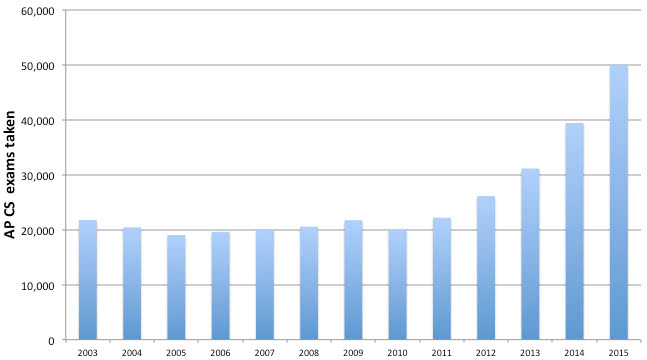
Code.org’s own courses continue to grow in enrollment, especially among younger students, and with a more diverse student population compared to the average for the field.

Over the last two years, Code.org and its partners have trained 20,000 new CS teachers (up from the 15,000 reported by USA Today in September).

In just two and a half years, over 100 school districts have decided to expand access to CS, including the seven largest school districts in the country. Chicago has pledged to make CS a high school graduation requirement. San Francisco has promised to teach it to every student in every grade. New York City has pledged to teach it in every school. Some of these large districts, such as Broward County in FL, or Charles County in MD, already teach CS in every high school.
In all of these school districts, Code.org provides curriculum and professional development to teachers, working with a fantastic team of partners, facilitators, and affiliates. Code.org can’t work with every single school district, so to provide options, we have identified curriculum and training partners ready to capitalize on the momentum behind CS.
In just two and a half years, community advocacy efforts led by nonprofits and corporations have resulted in policy changes across 17 states, including enabling CS to count for high school graduation credit, funding expansion of CS, and (in Arkansas) requiring schools to offer CS courses.
Additionally, over 100 K-12 and university experts have joined forces with state and local education leaders to to define a Framework for K-12 Computer Science.
At the national level, U.S. law finally recognizes CS as part of STEM education, and classifies CS in the recommended list of “well rounded education subjects”.
Internationally, in this same short time, 6 countries have announced nationwide plans to embrace computer science: the UK, South Korea, Saudi Arabia, Argentina, Australia, and Italy.
It has been an incredible two and a half years for computer science. We’re so proud of the progress that has been made thanks to the combined efforts of so many organizations who share our vision.
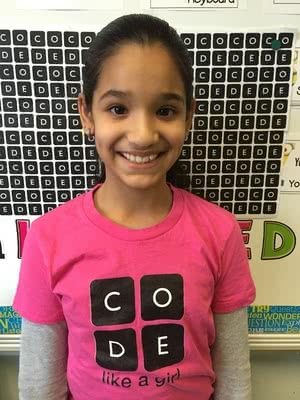
Julainee is a ten year old who lives in a low income housing area in New York, and resides with her mother, grandmother, and five siblings. She is a fifth grader at a Title 1 school, where she was first introduced to Code.org’s online curriculum. She fell in love with computer programming. She would go home every night and hand-write a program, showing up to school the next morning begging to see her code in action. Not only has Julainee become increasingly engaged with CS, she is now using her CS skills to connect with other students. She has included students with autism and English language learners on her journey. CS has the power not only to help students learn skills, but also to help them be important community members who make positive impacts on other people’s lives.
At Code.org we are big believers in using metrics to measure our impact. Along with the table below, you can also read our 2015 Evaluation Report.
| Code.org Goal | End of 2013 | End of 2014 | End of 2015 |
|---|---|---|---|
| Inspire students and increase diversity with the Hour of Code | 20 million served | 90 million — 48% female | 195 million served. 49% female |
| Engage classrooms and students in our computer science courses | 10,000 classrooms, 500,000 students | 90,000 classrooms, 4M students | 250,000 classrooms, 8M students |
| Improve overall diversity in CS | N/A | Our students are 43% female, 37% African American or Hispanic | 43% female, 37% African American or Hispanic (New survey pending) |
| Help school districts implement CS curricula | 10 district partners | 60 district partners | 100 district partners |
| Train new CS teachers across grades K-12 | N/A | 4,000 | 20,000 |
| Lead a coalition to set policies supporting CS. Policies changed in: | 5 states | 16 states | 17 states, including $9M in CS funding |
| Go global | 30 languages supported | 34 languages, 7 international partners | 46 languages, 70 international partners |
| Team size | 14 | 38 | 54 |
| Total $ spent (since founding) | $3.2M | $12.1M | $26.3M |
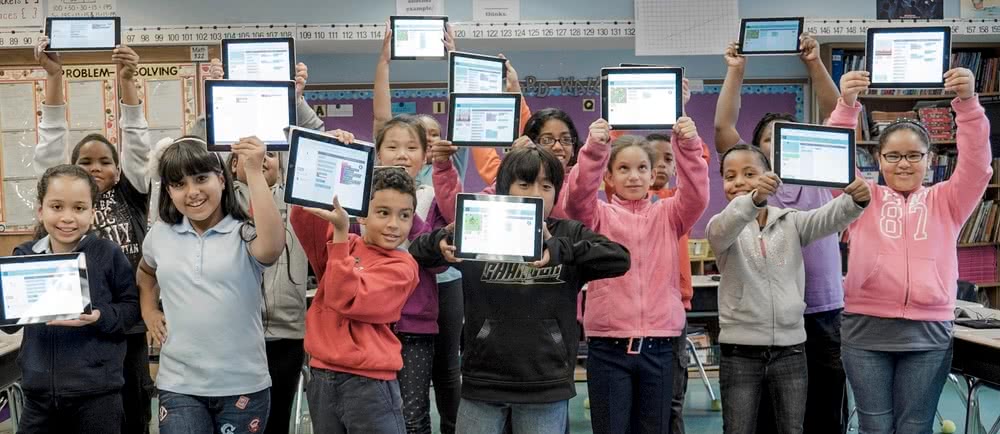
Code.org’s marketing campaigns have reached over a hundred million students and parents to grow interest in computer science. Recent studies suggest that CS has achieved broad awareness. While it’s impossible to measure how much is due to our work, the data clearly shows that Americans widely support our vision that every student in every school should have the opportunity to learn computer science:

The Hour of Code campaign, which culminates in Computer Science Education Week each year, aims to break stereotypes and show that anyone can learn computer science. This campaign has mobilized almost 400 partners worldwide in a grassroots campaign that has engaged 200,000 educators across every country globally to reach tens of millions of students. This year we released headline tutorials built in partnership with Star Wars and Minecraft, as well as dozens of other options including a new set of teacher-led lesson plans.
"I loved it, purely and wholly. It was fun to do, I want to just do that over and over again because I really enjoyed what I could do with it. I enjoyed its interactivity and how it felt to control what happened, it felt really satisfying to me. I wish we could do it every day."
— a middle school student on the Hour of Code Nampa, Idaho
For Computer Science Education Week in December, participants logged a cumulative 50 million hours served, roughly double the prior year, bringing the all-time total to 195 million hours served.
During the week we were inundated with powerful stories from all corners of the globe.

"Our students asked to have an hour every week." — Corinthia Azaniah Carter, Brooklyn, NY

"I feel that I'm a part of spreading something big. This is going to make the future." — Nicholas Gallimore

"The best 3 days of my 30 year teaching career." — Sandra Taylor

We recently published our approach to growing diversity in K-12 CS, explaining how we have deliberately weaved a plan for diversity throughout all our programs. In a field that is typically dominated by White and Asian males (with women or students of color representing less than 20% of students), we are encouraged by our progress:
| Code.org program | Scale (students) | % female | % students of color (Black, Hispanic, Pacific Islander, Native American) |
|---|---|---|---|
| Hour of Code | Tens of millions | 49% | 38.7% (U.S.) |
| CS Fundamentals for K-8 | Millions | 45% | 49% (U.S.) |
| Exploring CS - high school intro class | Tens of thousands | 37% (U.S.) | 56% (U.S.) |
| CS Principles - high school AP class | Thousands | 30% (U.S.) | 57% (U.S.) |
Code.org is building a full K-12 curriculum pathway on our Code Studio learning platform. Our pathway begins with CS Fundamentals for elementary grades, CS Discoveries* for middle grades and early high school, and CS Principles for high school. In addition, we partnered with Bootstrap and Project GUTS to provide two offerings - CS in Algebra and CS in Science - to integrate into middle school math and science classes.
*Note: Our CS Discoveries course is still in the early stages of development, to be a successor to the Exploring CS course that is taught in our high school classrooms today. The rest of the above courses are already being taught in hundreds or thousands of classrooms.
| Basic usage stats on Code Studio | |
|---|---|
| Registered student accounts | 8,553,924 |
| Last 90 day active student accounts | 4,417,525 (skewed by Hour of Code) |
| Registered teacher accounts | 256,340 |
| Last 90 day active teacher accounts | 128,675 (skewed by Hour of Code) |
In just two and a half years, Code.org and our partners and affiliates have trained 20,000 new CS teachers (up from the 15,000 reported in September by USA Today). These teachers span numerous courses and grade levels, although the vast majority of them are trained in CS Fundamentals curriculum (K-5).
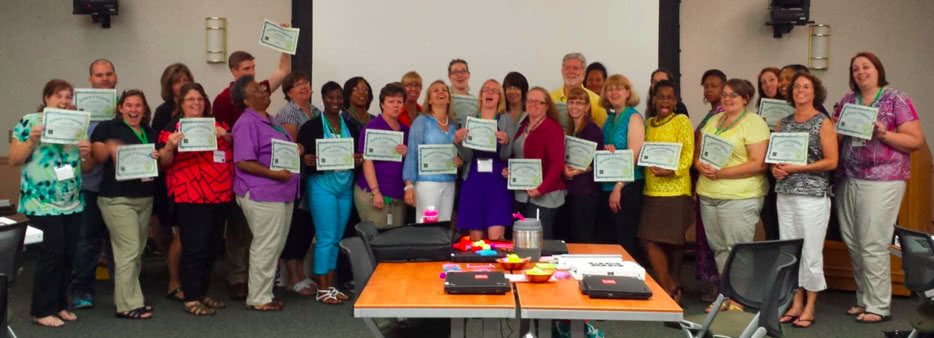
The majority of teachers who attend our professional development workshops rank them the “best ever” training they’ve received. While it’s a big compliment, this isn’t only about the work of Code.org — it’s because we’re part of a teacher-led movement to empower teachers to bring new opportunities to their students and classrooms, and it’s because of the fantastic facilitators, Affiliates, and partners we work with to run these workshops.
To recruit a local school or teacher to support computer science and join the movement, send them this letter.
This past summer our first cohort of teachers finished a complete cycle of professional development, allowing Code.org to calculate our all-in cost per teacher.*
| Estimated cost per teacher who completes PD | Estimated cost per student enrolled | |
|---|---|---|
| High school | $4,400 | $33 |
| Middle school | $2,300 | $8 |
| Elementary school | $150 | $1 |
*These costs were accumulated starting from Aug 2013 through Aug 2015, and they include all of Code.org's organizational costs to prepare these teachers to offer computer science in classrooms. (see more details on the methodology and comparables for these numbers)
We are now in partnerships with over 100 U.S. school districts.
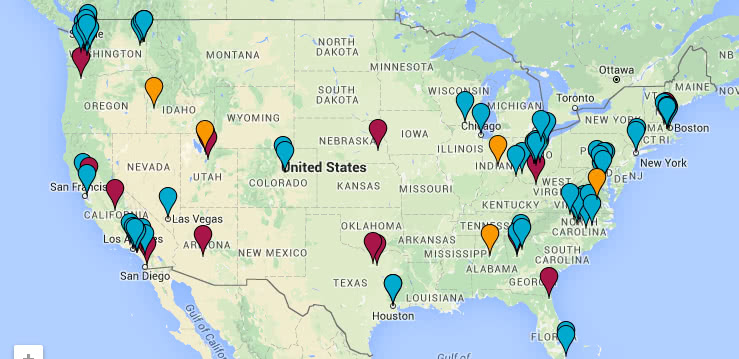
This year we also announced a landmark partnership with the College Board to collaborate in spreading computer science in U.S. schools, and we're already seeing benefits from the partnership.
A full list of 100 cities and districts in partnership with Code.org is here.

This year’s biggest wins were legislation in Arkansas requiring all schools to teach CS, and in Washington, providing funding to expand CS at the K-12 and the university level.
Code.org has also begun forging implementation partnerships at the state level, collaborating with state-level education departments or affiliated nonprofits to implement CS in schools. We’ve established partnerships in Idaho, Utah, Georgia, and Alabama.
Below summarizes what has changed among states in the 2.5 years since we began our work. None of this would have been possible without the amazing collaboration by our coalition of partners and other community stakeholders.
States that have changed policies (since 2013) to allow rigorous CS courses to satisfy high school graduation requirements in math or science include: AL, AZ, AR, CA, FL, ID, IL, KY, MD, MN, NY, OH, TN, VA, WA, WV, WI. (On deck: NJ and NE. See map above)
States that have developed or are evaluating development of state education standards for computer science: AR, FL, GA, ID, IN, IA, MA, MD, TX, UT, WA. (California is incorporating computational thinking into their curriculum framework for science)
States that have allocated funding specifically to computer science (in 2015): AR, GA, MA, WA - $9M in total across these 4 states. (Others are evaluating following suit)
States that have established state-wide partnerships with Code.org to expand computer science: ID, UT, AL, GA
Arkansas has required every high school to teach CS, tripling the number of students taking courses within months (Texas has too, but without supporting funds for implementation). Other states are evaluating similar moves (e.g. Iowa's STEM Council has recommended making CS a graduation requirement for all students).
To advocate within your state, see our map and state-specific factsheets. For details on what is happening on a state-by-state basis, see this detailed document.
For most states and school districts, the notion of CS for every student is a relatively new and unexplored topic. States and school districts are now thinking about how to make CS part of core academic work. They are asking big questions of the computing community: What is the appropriate scope and sequence for K-12 CS? What does the community expect every student to learn in elementary school, in middle school, or by the time they graduate high school? And why?
Code.org has joined forces with the Computer Science Teachers Association (CSTA) and the Association for Computing Machinery (ACM), along with more than 100 advisors within the computing community (higher ed faculty, researchers, and K-12 teachers), several states and large school districts, technology companies, and other organizations to steer a process to build a framework to help answer these questions in 2016. A steering committee initially comprised of the CSTA, ACM, and Code.org will oversee this project, which is housed at K12CS.org.
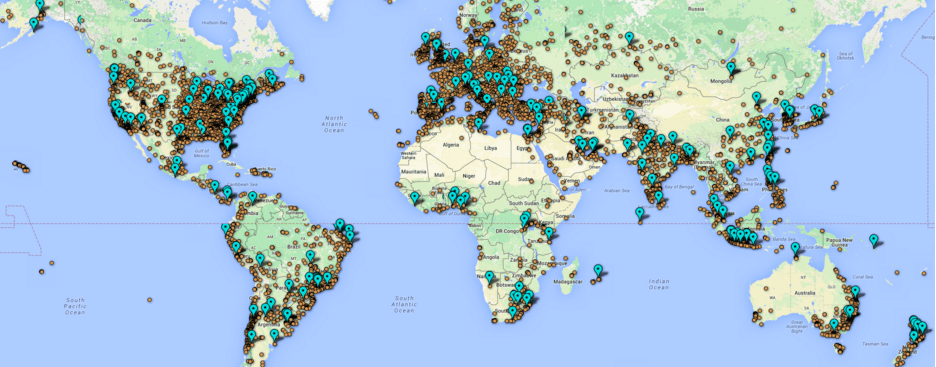
While the focus of Code.org is on K-12 schools in the United States, our work leaves a long tail of global impact. The work we do internationally is limited to harnessing the passions of others - whether volunteers to translate our courses, or partners to help spread the Hour of Code.
We have established 70 international partnerships to expand the Hour of Code campaign, and translated the Hour of Code tutorials into 46 languages. Thanks to our partners and volunteer translators, the 2015 Hour of Code was the largest ever, and over 40% of the participating classrooms were outside the US.
Our full CS Fundamentals course is translated into 16 languages, and many of our international partners are helping spread the course globally.
In 2015, Australia, Argentina, Italy announced nationwide plans to roll out CS as part of the national curriculum, joining the UK, South Korea, and Saudi Arabia that made similar announcements last year. Code.org plays little or no role in these announcements, although in many of these cases the local organizations in these countries have forged partnerships with us to collaborate on the work.
For details, see our crowdsourced state of international K-12 computer science education.

For calendar year 2015 our total expenses were $14.3 million. The chart below paints a general picture of how this money was spent.

The information above is based on audited financials and was updated on May 2016.
The table below shows the total cost breakdown of our headline achievements since founding.
| Areas of effort / Achievements in 2013 - 2015 | Fully-loaded cost (including admin) |
|---|---|
| Marketing: Hour of Code campaign, 200M served, 198,000 events in 196 countries. 48% female participation | $6.0 million |
| Curriculum + Code Studio learning platform: ~300 hours of coursework created, 250,000 teacher accounts. 8.5 million student accounts. 43% female, 37% black + Hispanic | $9.3 million |
| Partnership + professional learning: 100 school district partners, 20,000 new CS teachers trained across grades K-12. ($3.2M spent on grades K-5, $6.3M on grades 6-12) | $9.8 million |
| Government affairs: Policies changed in 17 states, $9.5M in state budgets allocated to CS, 2 Federal bills recognize CS. | $1.4 million |
| TOTAL SPENT (2013-2015) | $26.5 million |
We’d like to close this report by thanking our donors and partners, the millions of students and parents and volunteers who support us, and especially the educators without whose effort none of this would be possible. Your support has fueled a sea-change in education, both in the United States and globally.
Thank you,
Hadi Partovi and the Code.org team